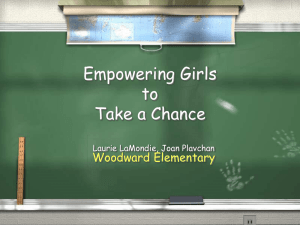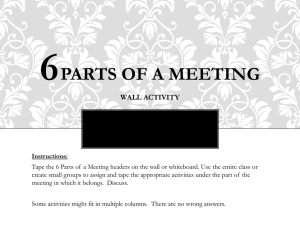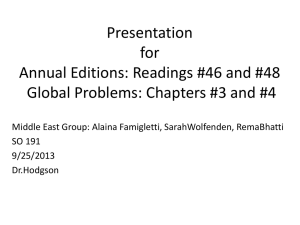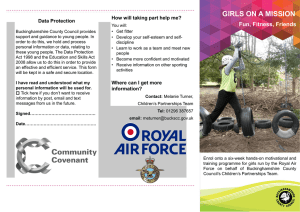Nancy Poole: Gender-informed practice and young girls
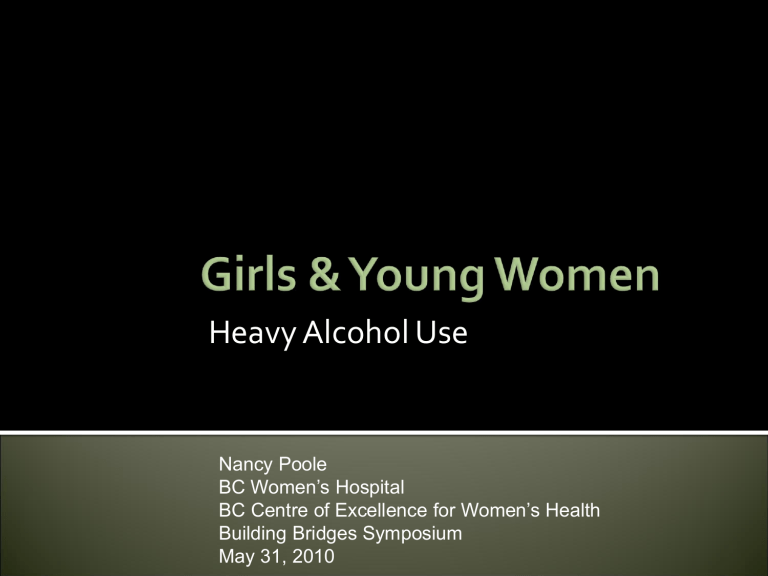
Heavy Alcohol Use
Nancy Poole
BC Women’s Hospital
BC Centre of Excellence for Women’s Health
Building Bridges Symposium
May 31, 2010
The 2008 BC Adolescent Health Survey found that male and female students surveyed in grades 7 through 12 were similarly likely to have ever tried alcohol (53.8% and 54.8% respectively) and equally likely to binge
Female students aged 15 or younger had a higher rate of binge drinking in the past month than their male counterparts 13.4 % compared to
11.8%.
Canada - In the 2004 Canadian Addiction Survey:
over 85% of the alcohol consumption reported by females aged 15–24 years of age was consumed in excess of the Canadian guidelines.
1 in 10 women ages of 15- 24 yr engaged in heavy weekly drinking (7.8% of girls 15-19 yr and 11.8% of young women 20-24 yr)
15 % of young women 18–19 yr & 11% of those 20–
24 yr reported heavy, frequent drinking.
Study of trends in the prevalence of monthly alcohol use and lifetime drunkenness in 20 European countries, the Russian Federation, Israel, USA and
Canada found drunkenness rates rise strongly between the ages of 13 and 15 in all countries
Girls appear to be catching up with boys in some countries. Canada was 1 of 5 countries where there were cases of rates of drunkenness more common among girls than boys ( Canadian girls 13 yr and 15 yr)
Compared to heterosexual youth the same age, bisexual females were two times more likely to report binge-drinking
Among bisexual females , the rate of bingedrinking rose from 12% in 1992 to 37% in 1998 to
43% in 2003. Among bisexual males, the rate of binge-drinking rose from 22% in 1992 to 32% in
1998 and remained at this rate in 2003.
Saewyc E, Poon C, Wang N, Homma Y, Smith A & the McCreary Centre
Society. (2007). Not Yet Equal: The Health of Lesbian, Gay, & Bisexual Youth
in BC. Vancouver, BC: McCreary Centre Society.
Health impacts
for girls/ young women
Girls are more vulnerable than boys to the health effects of alcohol, for example some sex differences include :
Hypertension
Osteoporosis
Reproductive health problems
Interrelated smoking risks
Pregnancy- unwanted/ unplanned/ unintended pregnancy & potential fetal harms (FASD)
Vulnerability to STI’s, HIV
Health impacts of heavy drinking for women
Increased risk for accelerated development of:
Liver disease (hepatitis/ cirrhosis)
Cardiac diseases and heart problems
Damage to stomach
Brain damage
Breast cancer
Oropharyngeal, oesophageal and liver cancers
Addiction
Pregnancy- unintended pregnancy & potential fetal harms
(FASD)
Alcohol can be even more dangerous for young women with body image or weight concerns. For girls who may not eat properly or who have a low daily caloric intake, drinking alcohol can place them at higher risk of intoxication and in extreme cases, of alcohol poisoning
McCarty, C.A., et al., Longitudinal associations among depression, obesity
and alcohol use disorders in young adulthood. General Hospital
Psychiatry, 2009. 31(5).
For 16 to 18 year old BC students:
Females were more likely than males to have self harmed whatever age they started drinking or using marijuana but the younger they were when they started using, the more likely they were to have deliberately injured themselves.
McCreary Centre Society (2010). What a difference a year can make: Early alcohol and marijuana use among 16 to 18 year old BC students
The Formative Years report demonstrates that girls and young women use cigarettes, alcohol and drugs for reasons different from boys, that the signals and situations of high risk are different and that girls are more vulnerable to substance use and abuse and its consequences.
One of the gender specific influences on girls drinking is the influence of exposure to the entertainment media and alcohol and cigarette advertising - which shower girls and young women with unhealthy and unrealistic messages about smoking, drinking and weight loss.
National Center on Addiction and Substance Abuse. (February
2003). The Formative Years: Pathways to Substance Abuse Among
Girls and Young Women Ages 8-22. New York, NY: CASA .
Females overestimate the amount of alcohol males want their female friends, dating partners, and sexual partners to drink and this misperception was associated with their drinking behaviour
LaBrie et al. (2009). What men want: The role of reflective opposite-sex normative preferences in alcohol use among college women. Psychology of Addictive Behaviours, 23(1), 157-1262.
Adolescents and young women between the ages of 16 and 24 are at greater risk of woman abuse than any other age and gender group
Tjaden & Thoennes, 2000, Extent Nature and Consequences of Intimate Partner
Violence: finds from the National Violence
Against Women Survey
are closely linked to heavy drinking for young women.
McCarty et al. 2009 Longitudinal associations among depression, obesity
and alcohol use disorders in young adulthood.
8-10% of teens reported that using drugs or alcohol was the reason that they had intercourse for the first time (Council of Ministers of Education,
Canada, 2002)
Girls 15-19 yrs have the highest rates of chlamydia and gonorrhea (PHAC 2004)
Multiple intersecting interconnections
Girls who experience physical & sexual abuse by dating partners are more likely to be at risk for harmful substance use.
(Note: Odds of 2.0 mean a girl is twice as likely to engage in the behavior as one who was not abused.)
Behavior
Heavy smoking (within 30 days)
Odds
2.5
Binge drinking (within 30 days)
Cocaine use (ever)
Diet pill use (within 30 days)
Laxative use & / or vomiting (within 30 days)
More than three sex partners (within 90 days)
Pregnancy (ever)
Considered suicide (within 1 year)
1.7
3.4
3.7
3.7
3.3
3.9
5.7
Attempted suicide (within 1 year) 8.6
Silverman, J. G., Raj, A., Mucci, L. A., & Hathaway, J. (2001). Dating violence against adolescent girls and associated substance use, unhealthy weight control, sexual risk behaviour, pregnancy, and suicidality. The Journal of the American Medical Association, 286 , 572-579
Risks
Low self-esteem
History of trauma
Depression, anxiety, eating disorder
Early onset of puberty
Lack of coping skills
Teen pregnancy
Poor relationships with family, peers
Peer and parental substance use
School transitions, frequent moving
Marketing, media
Protective Factors
Healthy self esteem
Positive body image
Religiosity/ spirituality
Parent-child attachment
Family rules against substance use
Parents encouraged their children to abstain
Peers with healthy attitudes toward risky behaviours
School connectedness
Social support
Support during key transitions
Move from
“fix a girl” to “prepare a girl”
(Watkins)
Support girls to:
1) Learn how to form close relationships
2)
3)
4)
5)
6)
7)
8)
Find a value place in a constructive group
Feel a sense of worth
Achieve a reliable basis for making informed choices
Know how to use the available support systems
Express constructive curiousity and exploratory behaviours
Find ways of being useful to others
Believe in a promising future with real opportunities
From Marie L Watkins “Listening to Girls: a study in resilience” in Resiliency: An
Integrated Approach to Practice, Policy, and Research, Roberta R Greene (Ed.) 2001
Achieve a competent gender-role identification
Establish an acceptable body image
Develop a positive self-image
Develop satisfactory peer relationships
Establish independence through responsible decision making
Understand sexuality
Learn to obtain and find access to resources
Plan for the future
LeCroy, C. W. & Daley, J. (2001). Empowering adolescent girls: Examining the present and building skills for the future with the Go Grrls program. http://www.public.asu.edu/~lecroy/gogrrrls/body.htm
Resiliency
Relational
Developmental
Harm reduction oriented
Trauma-informed
Culturally informed / safe
Resiliency, strengths based
Developmental
Relational
Culturally competent
Trauma informed
Harm reduction oriented
http://www.public.asu.edu/~lecroy/gogrrrls/gogrrrls.htm
National/ USA
12- session school-based group for girls 11- 14 yrs
Curriculum based on key developmental tasks
Relational
Empowering
Companion parent curriculum
Girls Workbook
LeCroy, C. W. & Daley, J. (2001). Empowering adolescent girls: Examining the present and building skills for the future with the Go Grrls program. New York: W.W. Norton & Company. (Facilitator guide)
LeCroy, C.W. & Daley, J. (2001). The Go Grrls Workbook. New York: W.W. Norton & Company. http://www.public.asu.edu/~lecroy/gogrrrls/body.htm
Girls Talk Program (VALIDITY project
- CAMH)
Young women support groups that that focus on everyday problems of young women
Hearing vs. treating
Taking advice from girls & young women
‘Hear Me, Understand Me,
Support Me: What young women want you to know about depression’ (VALIDITY project) www.camh.net
Voices
Group program for girls at varying levels of risk, can be run in different settings
Grounded in gender-responsive principles & key theoretical foundations
Gives girls a safe space, encouragement, structure and support
Focus is on 4 areas in lives of girls: self, connecting with others, healthy living, the journey ahead
Covington, S. (2004). Voices: A program for self-discovery and empowerment for girls. Facilitator guide. Carson City, NV; The Change Companies. http://www.stephaniecovington.com/books.asp
provides marginalized and atrisk girls ages 12-19 with a space to explore a wide range of issues that impact their daily lives, as well as their strengths and daily lived realities in a safe and nonthreatening environment.
Bell-Gadsby, C., Clark, N., & Hunt, S. (2006). It's a
Girl Thang!
Celebrating strengths
Safety
Female mentors and role models
Developing and supporting leadership skills
Empowering girls to be forces for social change
Media literacy
Physical, sexual and mental health information
Cultural connections
Solidarity between girls and women
Covington, S. (2004). Voices: A program for self-discovery and empowerment for girls. Facilitator guide. Carson City, NV; The Change Companies. Pg. 18.


